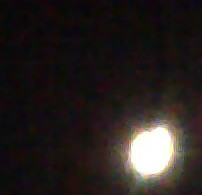


We use the topocentric position of the moon for our calculations of the vaiṣṇava calendar. In other words, we take the parallax of the moon into consideration. This means that there is a difference from others who use the geocentric position of the moon. There is some explanation of this here. We use the topocentric position of the moon because that's what is observed by an observer on earth. The following table illustrates the differences:
 |
 |
 |
| This is a photograph of the moon | Using the topocentric position means using the position of the green symbol | Using the geocentric position means using the position of the red symbol |
We have done some research that shows that these differences are on average two ekādaśīs a year.
For those events that appear on new moon or full moon days, such as Gaura Pūrṇimā, our research shows that almost 6% of the earth's surface will observe the event on different dates, depending on which method is used for the moon's position.
For those events that appear between new moon and full moon, such as Janmāṣṭamī, our research shows that about 0.7% of the earth's surface will observe the event on different dates, depending on which method is used for the moon's position.
These differences are generally bigger for places near to the equator than for places near the arctic regions.
The reason why ekādaśīs occur on different dates for 8% of the world's surface on average is the occurance of special mahādvādaśīs, especially pakṣavardhinī mahādvādaśī, which can sometimes create very big differences.
Some further reasons to use the topocentric position of the moon: There is a quote, supposedly from Varahamihira or one of his disciples:
yadā yaś caiva siddhānto gaṇite dṛk-samo bhavet, which is translated as "any siddhānta that coincides with observations must be used".
The Siddhāntasundara, which was written in early 16th century C.E. gives formulas for calculation the topocentric position of the moon,
so such calculations have been used for calculation of solar eclipses.
Having said this, the burden of proof really lies on the people, who want to use the geocentric position of the moon for their calculations.
UPDATE 7 June 2016: There has been some discussion online, where someone argued for the use of the geocentric position of the moon by claiming that the Sūrya-siddhānta mentions corrections according to parallax after mentioning tithi, but before mentioning solar eclipses and moonrise. That is taken as an indication to use the geocentric position for tithis, but the topocentric position for solar eclipses. That seems to be a very far-fetched interpretation of the scripture. We don't agree with that opinion, but at least, it actually begins to give some credibility to the idea of using the geocentric position of the moon, so it's not quite as absurd as we originally thought, although it still needs further reasons to be taken seriously. Nevertheless, some respected calendar-makers in India have spoken against the idea of using one calculation for tithi and another one for solar eclipses.